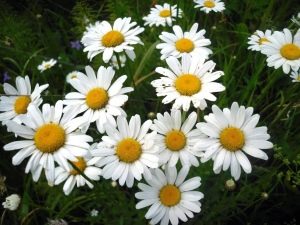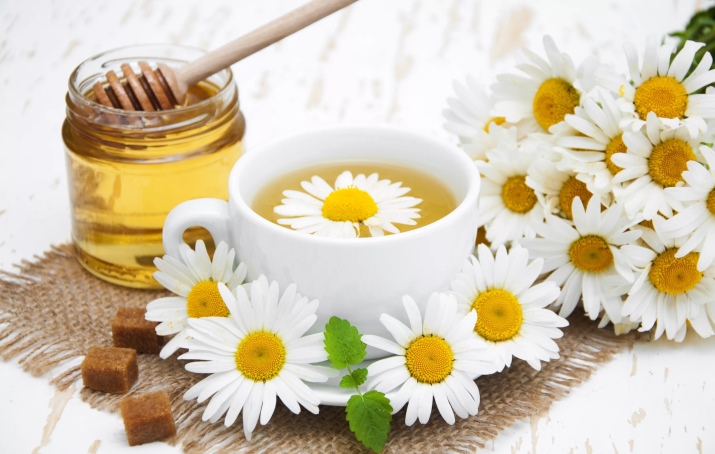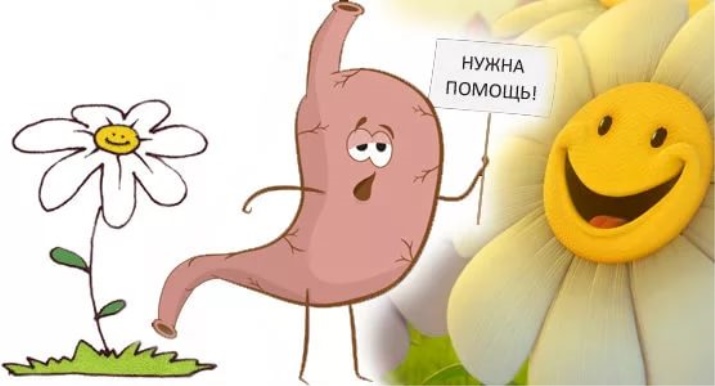Field chamomile

Field chamomile - one of the most common plants in our limitless expanses.It is used for many purposes, especially distinguish its medicinal and cosmetic properties. Chamomile is also known for its honey-bearing abilities and use in cooking.
The homeland of chamomile, interesting facts, its features and species diversity, application, collection, harvesting, storage, cultivation at home - this article will tell about this and many other things.
Special features
Field daisy - a unique flower. Annual composite plant belongs to the Aster family. It is found in the wild and is also cultivated. Description of the plant: winding, hollow stem up to 60 cm long, leaves bright green, narrow, alternate, inflorescences - baskets, with flowers on the edge of white, like tongues, numerous, internal yellow flowers resemble tubules, hollow.
The medicinal plant has a number of features:
- Homeland daisy - North America. The growing area is both hemispheres, with the exception of the tropics. In Russia, the annual is found in the middle lane, in the Urals, Transbaikalia, and the Far East. Major manufacturers and importers of pharmaceutical drugs southern countries (Brazil, Argentina) and European countries (Germany, Czech Republic).
- Chamomile loves the light. The appearance of its flower passes through three states: in the morning the petals look down, in the afternoon they are fully stretched and horizontal to the ground, after sunset the sun is pressed against the stalk.
Healing is known since ancient times. In the Middle Ages, chamomile became a real panacea - it disinfected wounds, healed women's diseases, took care of the skin of the face and made life easier for the "ventricles". In the 19th century, the use of the annual was practically reduced to zero, only cosmetologists continued to benefit from it. But the 20th century, with its progressive views and the development of laboratory medicine, returned interest to chamomile. Scientists, having disassembled the chemical composition, brought the flower its former glory and put it on a par with other medicinal plants.
The properties of the flower are thoroughly studied by botanists, pharmacologists and adherents of traditional medicine. Its advantage is achieved due to its rich composition: acids, flavonoids, vitamins, essential oils. The combination of microelements and their balanced amount give a healing effect.
Everyone knows the miraculous properties of flowers, but few know about the action of the plant root:
- It is also concentrated biologically active substances. A powder is made from the root and it is used to treat disorders of the urogenital system, allergies, and nervous conditions.
- Tibetan medicine is known for its non-traditional treatment approaches. Chamomile plays an important role in it - this flower has become a component of the means for rejuvenation.
- Chamomile is sold in several forms: dry raw materials (dried inflorescences, tea, fees), tinctures, capsules, essential oil, plant-based cream and ointment.
Types and names
The history of field chamomile began long ago. At different stages of the development of medicine, in different states, the plant had several names.
The earliest is chamaemelon. The meaning of this word in the external features of chamomile is a plant on the ground (short stem) with an apple smell (a peculiar floral aroma resembling a sweet fruit).
In medieval Europe, the annual was called chamaemelon romana. In Russia, he had the name Romanovskaya grass. That is, chamomile - diminutive pet from the "novel".
The scientific name in Latin is introduced by the nerd Galler and sounds like Matricaria. The word is derived from Matrix, which means uterus (according to another version, from mater - mother). Chamomile received this name due to its powerful properties to treat female gynecological diseases.
Scientists identify several types of chamomile, which has healing properties and is used in medicine, cosmetology:
- Pharmacy (Matricaria recutita). Medicinal chamomile - a valuable and miraculous plant, it is used externally and internally for the treatment of many diseases, skin care, hair.
- Bezyazchkovaya (Lepidotheca suaveolens). Its other names are more known - fragrant, chamomile, yellow chamomile, small. The height of the plant reaches 35 cm, at the beginning of flowering it looks like a ball, after - an egg. It differs from the pharmacy in the absence of white reed flowers. Use - for external use only.
- Odorless (Tripleurospermum perforatum). The main difference from the pharmacy - the receptacle is not hollow. Rarely used in medicine.
- Roman. It is widely used in Western Europe, cultivated in garden plots, propagated by vegetative means. According to the properties similar to the pharmacy, used in medicine and cosmetology.
- Nivyanik - A plant that is common in the fields and gardens of summer people as a decorative flower. The smell of her less pronounced than that of the pharmacy, is not used in medicine.
Useful and healing properties
The benefits of chamomile due to its chemical composition. Scientists in the plant found proteins, essential oils, azulene, apiin, salicylic acid, fatty acids, mucus, vitamins E, C, B, K, which are important for humans.
Due to the combination of biologically active substances, chamomile has the following beneficial and healing properties:
- improvement of appetite, assimilation of food;
- increasing the protective properties of the body, "building" a barrier against infections and microbes;
- wound disinfection;
- relieving allergy symptoms;
- relieving inflammation, bleeding, cramping;
- reduction of emotional stress without a sedative effect;
- stool normalization in case of poisoning;
- normalization of the liver, kidneys, stomach;
- cleansing the skin, giving it a smooth and velvety;
- for hair - stimulation of their growth, activation of the hair follicles.
Contraindications
Despite the fact that the field chamomile has many useful properties and is used in many areas, it has several contraindications:
- Medicine forbids taking decoctions and tinctures to pregnant women. The flower activates the production of female hormones - estrogen, which leads to hormonal imbalance. For the normal course of pregnancy, this imbalance is unacceptable. Nursing mothers are carefully prescribed flower-based medications.
- Chronic illnesses and regular intake of life-saving medications may also be contraindicated. Only a doctor, assessing the situation, will allow or prohibit the simultaneous administration of chamomile and other medicines.
- Uncontrolled and excessive use of chamomile-based products can lead to migraines, vomiting, high blood pressure, bleeding.
- Individual intolerance to chamomile is fraught with bronchospasm or edema.
- For eye diseases, compresses are used only after examination and consultation with your doctor.
Application
A wide range of chamomile applications are divided into three large blocks.
Drug use
Healing properties are highly valued both in traditional medicine and in traditional medicine. It helps to treat a huge range of diseases:
- Colds. Tea from dry flowers has a diaphoretic and antipyretic effect, effectively fights viruses and infections. Gargling relieves pain, relieves inflammation, inhalation helps with inflammation of the nasal mucosa;
- Diseases of the gastrointestinal tract. Chamomile envelops and softens the mucous membrane of the digestive organs, neutralizes slags, reduces inflammation, eliminates irritations, lowers acidity. In conjunction with other medicines used in the treatment of gastric ulcers, colitis, gastritis;
- Sleep disturbances, nervous overstrains. Chamomile tea with honey helps to relax, it promotes fast sleep and a quiet, healthy sleep;
- Female diseases uterus, ovaries and irritation of the mucous membranes of the genital organs are treated with douching and baths;
- Kidney disease and disorders of the bladder. A decoction will relieve pain, inflammation, perform the function of antispasmodic;
- Skin diseasessuch as eczema, boils, allergies.Itching, redness, inflammation eliminate infusions and decoctions in the form of lotions.
In cosmetology
Chamomile is added to many cosmetic products and used at home. it is used for the following purposes:
- protection of the skin of the face from photo-aging, harmful effects of the environment, elimination of toxins, products of intracellular metabolism;
- plant-based masks improve skin structure, regenerate it, clean;
- a decoction of flowers perfectly vaporizes the skin before mechanical cleaning, and after the procedure, washing removes redness, heals wounds and disinfects;
- lipstick with chamomile extract moisturizes lips, creating protection from the negative effects of the sun and dust;
- essential oil is used in the fight against cellulite, leveling the skin surface and nourishing it with moisture;
- decoctions strengthen hair, giving it a tone, mobility, liveliness and shine.
On how to make a face mask with chamomile, which will be an excellent tool for girls, see below.
Other applications
Chamomile can be used, for example, in food production. Essential oil flavored liqueurs, tinctures, added to food as a spice.
Light industry uses the plant as a natural dye. In the yellow color is painted wool and silk.
In veterinary medicine, dogs, sheep, cattle are treated with flowers. Gardeners chamomile helps with aphids, mites, caterpillars, mosquitoes.
When and how to collect?
The flowering period is the ideal time to collect chamomile. Experienced gardeners collect it on the fifth day after blooming. The flower looks like this: the yellow center is half open, the white petals are in a horizontal position. This is a signal that the maximum concentration of vitamins, nutrients and essential oil is reached in the plant.
Collection is carried out in dry sunny weather. Inflorescences should be carefully plucked from the stem or use a special device (for picking berries - blueberries, lingonberries, cranberries). It is also allowed to pluck flowers along with the stem. It is forbidden to pluck a flower from the root.
Stocking
Connoisseurs of medicinal plants know that harvesting chamomile is not so easy. This process is divided into several stages:
- The first stage - the collection. It is described in detail in the previous section. Chamomile blooms from late May until September. During the season (growing season), the collection is carried out three times. After flowering, the plant gradually loses its usefulness and its preparation is inexpedient.
- At the second stage, the raw materials are dried. Responsible procedure, the quality of the annual for its subsequent use depends on the correctness of its execution. If only flowers were harvested, they are laid out on a clean surface: cloth, newspaper, window sill, flooring. Direct sunlight is completely excluded, the shadow and air circulation will be organized. If the daisy is torn from the stem, it is tied up in bunches and hung in a dark ventilated room on the walls until it becomes dry and rustling. It is not recommended to dry the plant in drying cabinets and electric dryers. High temperature kill all beneficial trace elements.
In the process of drying, the chamomile is turned over several times - this allows you to create air flow between the flowers, which will ensure quick drying. The stage lasts from several days to two weeks. 1 kg of chamomile is equal to about 230 g of dry raw materials.
The last stage is preparation for storage. There are several possible options:
- The easiest is to store it in a clean cardboard box in a dark, cool place.
- Chamomile looks unusual in glass jars. They can be placed in the first-aid kit and original decorate.
- Fabric bags - textiles must be chosen natural, not dyed, clean. Chamomile neatly folds into the bags and hang them on the wall. So the flowers will remain whole and will not turn into a homogeneous dry mass.
How to start harvesting chamomile and how to dry it? A detailed video to help those who prefer to treat various diseases with herbs.
How to grow and propagate at home?
In order not to worry about collecting chamomile in the fields, it can be grown at your dacha. For proper cultivation, gardeners recommend adhering to the following rules:
- Sowing time - the end of August, the beginning of September or the beginning of spring. Sowing before winter gives a richer crop;
- the plot should be well lit, not in the shade;
- soil preparation - dig up to a depth of 25 cm, fertilize with manure, add nitrogen, phosphorus and potassium;
- optimal soil is alkaline, sandy;
- carrying out the drainage of the soil, so that the soil will remain the minimum water content and improve the ventilation of the air in the root system of the plant;
- regular feeding of soil fertilizers of organic and mineral origin;
- watering - in the first days after planting and in the heat;
- with improper care, the daisy will resemble a wild flower and will become a common weed.
Chamomile breeding occurs by dividing the bushes. In the fall, the seeds are planted in the ground, if planting is carried out in the spring - seedling bushes are planted.
As for growing at home, chamomile will require investment of effort, time and work. It is not easy to cultivate it on the windowsill, as it constantly needs light, active summer and spring sun, soil minerals and other fertilizers.








































